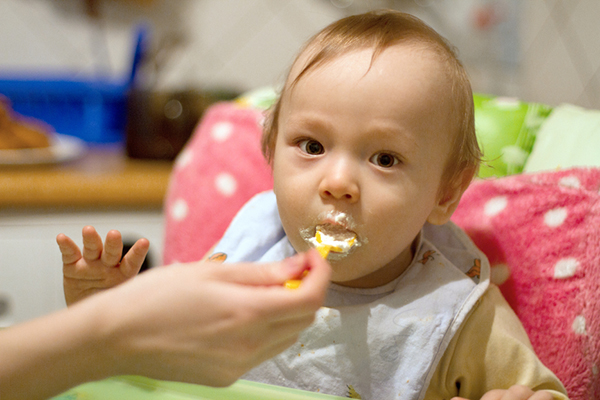
When baby is ready for solids her world expands to include meaningful family mealtimes, colorful messes and even bursts of excitement over new flavors. However, the solid food transition can be stressful for first-time parents.
Rachel Rothman is a registered dietitian and pediatric feeding expert. In her practice, Nutrition in Bloom (in Hillcrest), Rachel works with children and families to provide feeding guidance and evidence-based nutrition recommendations. She teaches infant and toddler feeding classes and facilitates group coaching throughout San Diego County and online. We caught up with Rothman to discuss infant nutrition and to develop quick tips for introducing solids.
Is Baby Ready?
At about 6 months old, many babies are ready to experiment with solid foods. There’s no harm in starting earlier or later, but there’s also no benefit. All children develop at different rates, so watch for readiness and follow the child’s cues. According to Rothman, babies who are ready for solids will:
- sit upright in a highchair
- exhibit good neck and head control
- open their mouths when food is offered
- seem genuinely interested in food
Purees vs. Finger Foods
There are two common methods for feeding babies. The more traditional path has been to spoon-feed purees. The alternative, which is growing in popularity, is to offer soft, appropriately-sized bites of food for baby to self-feed as desired. This method is often described as “baby-led weaning.” Both methods require a little research, and parents might find that the topic can be polarizing. What matters most is to choose a method or combination of methods that work well for the unique needs of the family.
“What is more important than how you choose to feed is to be responsive to [their cues],” says Rothman. “All babies are different and respond to feeding differently. At meal time if they have a closed mouth, or aren’t into feeding, don’t put pressure on them. Feed responsively.”
Which Foods to Offer First
In the past, parents were advised to introduce fortified rice cereal first. Baby cereal can be a wonderful choice, because it supplies additional iron and zinc that children require around 6 months of age. However, it is possible to acquire those nutrients from other foods. Any easily digestible food is a great choice for baby’s first solid meal. Some parents find it helpful to introduce a baby’s palate to vegetables before fruit (fruit is significantly sweeter). Many prefer to offer a variety of fruits and vegetables before introducing meats.
“I recommend parents think about variety as they begin to offer foods,” Rothman says. “Many people call the first 6 months of feeding the ‘honeymoon period,’ as infants are more likely to try new foods and may become a little pickier as they enter into toddlerhood.” Rothman created a helpful guide to get parents thinking about important nutrients and how to incorporate them into baby’s diet. Access it at HERE.
Allergy Awareness
According to the American Academy of Pediatrics (AAP), parents should introduce higher allergenic foods early and often. The top eight most allergenic foods include peanuts, tree nuts, eggs, fish, shellfish, milk, soy and wheat.
“I recommend parents chat with their pediatrician prior to offering these foods, especially when food allergies run in the family,” advises Rothman. Research indicates that early and frequent exposure to these foods might help to prevent serious allergies.
Picky Eating
It’s developmentally appropriate for toddlers to express themselves by refusing certain foods. Parents should continue to make those foods available, even if they are rejected several times. The last thing families want is a power struggle at mealtimes, so it’s best not to resort to punishment or bribery.
While it would be wonderful for toddlers to eat from each of the food groups daily, we can’t force them. Some pediatricians advise parents to focus on weekly nutrient intake instead. A child who rejects veggies on Monday might request extra broccoli on Wednesday—and that’s OK.
“I am a huge fan of getting kids in the kitchen as early as possible, so they can have more interactions with food, besides just at the table,” says Rothman. “Food is a full sensory experience: see, touch, smell, taste, listen. I love recommending parents try to get all senses involved.”
For more from Rachel Rothman, including feeding tips and recipes, visit Nutrition in Bloom at www.nutritioninbloom.com or find her on Instagram @nutrition.in.bloom.
Anne Malinoski is a contributing writer and mother of two boys. Her kids may not eat everything she serves, but they love to help out in the kitchen.
____________














